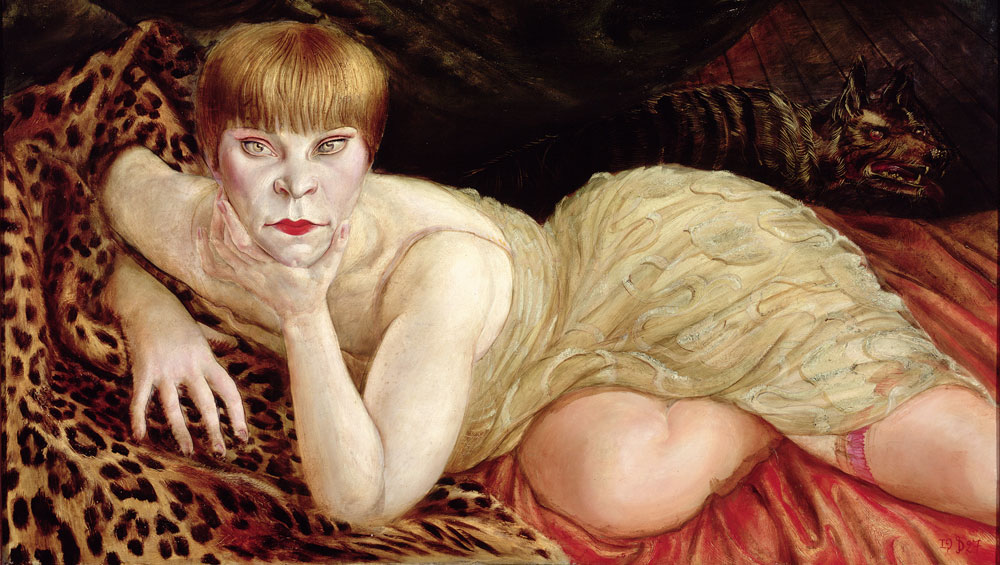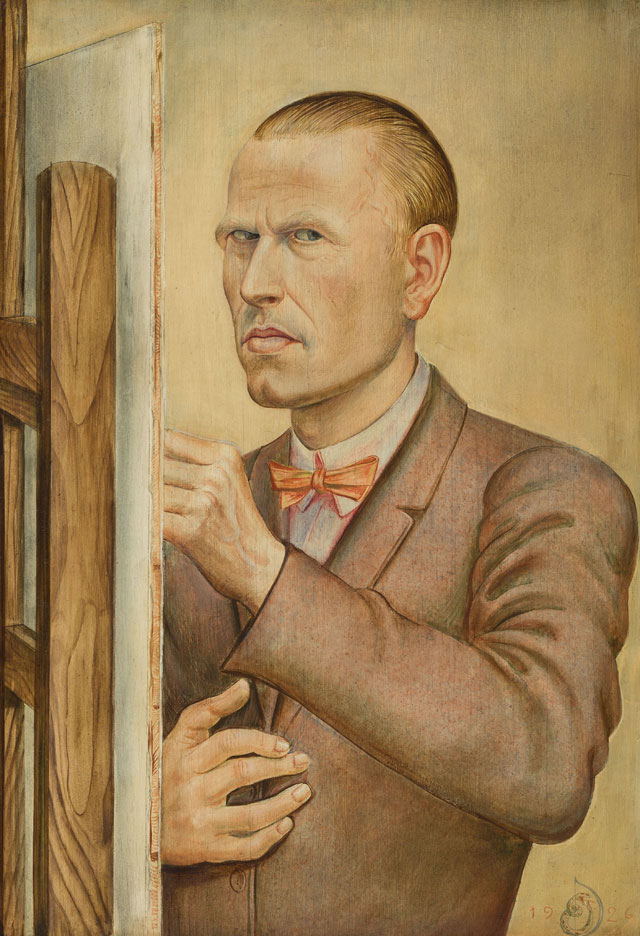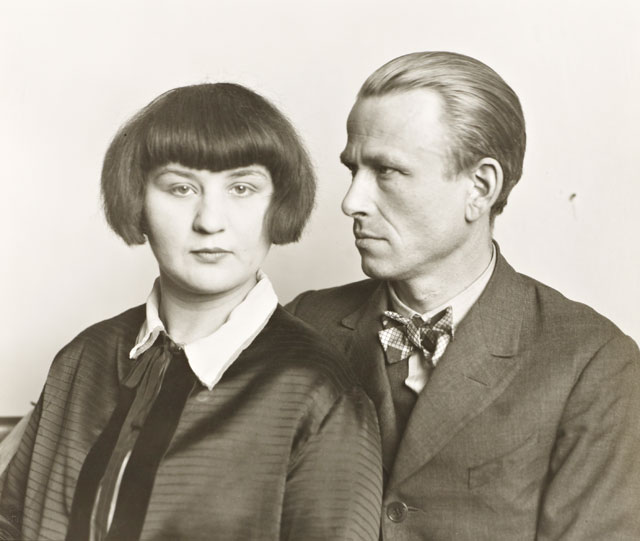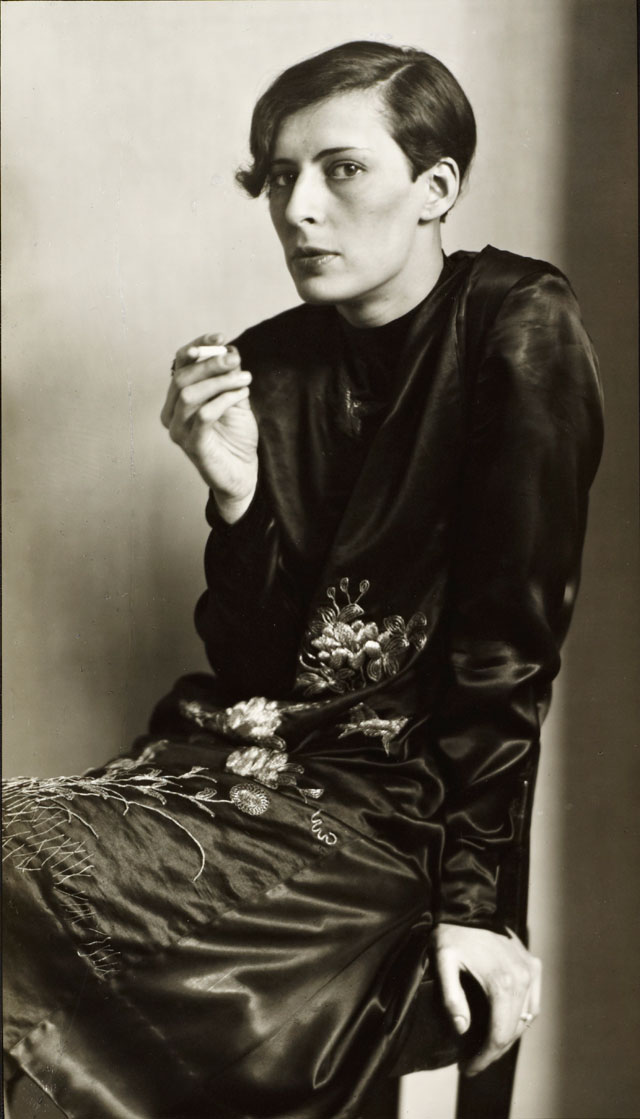
Tate Liverpool
23 June – 15 October 2017
by ANNA McNAY
In its 14 years (1919-33), the Weimar Republic – as the newly established German state was unofficially known – faced numerous problems, including hyperinflation, unemployment, political extremism (with paramilitaries – both left- and rightwing), and troubled relationships with the victors of the first world war. It was also, however, as is common in such periods, an era of remarkable cultural renaissance, a boom time for clubs and bars, and a phase of great creativity in terms of literature, cinema, theatre and music. Visual artists, too, responded to the sociopolitical climate, with Otto Dix (1891-1969) in particular combining realism and criticality with his singular artistic vision to produce paintings showing the manifold extremes of this tumultuous interwar period.

Otto Dix. Self-Portrait with Easel 1926 (Selbstbildnis mit Staffelei), 1926. 80 x 55 cm. © DACS 2017. Leopold-Hoesch-Museum & Papiermuseum Düren. Photograph: Peter Hinschläger.
For this dual exhibition at Tate Liverpool, a selection of Dix’s work, primarily from his years in Düsseldorf between 1922-25, and including his barren series of 50 etchings The War(1924), is set against more than 140 photographs from the Artist Rooms collection of photographer August Sander’s monumental project, People of the 20th Century. Photographing subjects from all walks of life, and later categorising them according to his self-devised, ever-evolving system, Sander (1876-1964) produced an incomparable record – or collective portrait – of a nation in flux. Shown here chronologically, alongside an informative textual timeline, the gelatin silver prints set the sociopolitical backdrop against which Dix’s dramas, across the hall, play out. While each exhibition is strong enough – and large enough – to stand alone, together they provide a comprehensive and fantastic insight into the life and times, the ups and downs, and the joys and horrors, of the Weimar Republic.
The timeline begins in 1919 with the murder of the revolutionary leaders Karl Liebknecht and Rosa Luxemburg at the hands of the proto-Nazi Freikorps, marking the end of a failed workers’ uprising in Berlin. This same year saw the signing of the Treaty of Versailles by the German delegation; the founding of the Bauhaus school by Walter Gropius; the third wave of Spanish flu, which killed more people worldwide than the entire first world war; and the approval by the National Assembly in Weimar of a new constitution making Germany a parliamentary democracy. For the following four years, political instability was rife. Six governments followed each other in quick succession, none lasting more than 18 months. The situation was worsened by economic crisis and social and financial hardship. Sander depicts these events reflected in the faces of his subjects: children, with the prematurely aged faces of miniature adults; widows, with earnest expressions, carrying the weight of their burden (the war left more than 600,000 widows, whose chances of remarriage were low, due to the high ratio of women to men, following the deaths of so many soldiers); and tradesmen radiating pride in their professions – blacksmiths, masons, farmers and peddlers, right through to circus workers – the full gamut.
The photographs of families and tradesmen are interspersed with those of artists and their lovers. Dix himself is portrayed with his wife, Martha (c1925-6) – she with a sharp bob and fringe cut to create a heart-shaped face, staring directly at the camera; he with a furrowed brow, gazing straight past her, into oblivion – a popular 1920s composition.

August Sander. The Painter Otto Dix and his Wife Martha 1925-6, printed 1991. Photograph, gelatin silver print on paper, 20.5 x 24.1 cm. © Die Photographische Sammlung/SK Stiftung Kultur - August Sander Archiv, Cologne; DACS, London, 2017.
Secretary at West German Radio in Cologne (1931) depicts the “new woman”, like Martha, with her hair cropped, shaped eyebrows and a cigarette, while the young man in Grammar School Boy (1926) holds a self-assured pose, with a cigarette in one hand and the other firmly planted in his pocket, well groomed, and with a certainty only youth can possess.

August Sander. Secretary at West German Radio in Cologne 1931, printed 1992. Photograph, gelatin silver print on paper, 26 x 14.9 cm. © Die Photographische Sammlung/SK Stiftung Kultur - August Sander Archiv, Cologne; DACS, London, 2017.
In July 1927, Sander showed 100 portraits from his fledgling project at the Kölnischer Kunstverein. That same year, he wrote: “Photography has presented us with new possibilities and new tasks. It can depict things in magnificent beauty, but also in terrible truth, and can also deceive enormously. We must be able to bear seeing the truth, but above all we should hand down the truth to our fellow human beings and to posterity, be it favourable to us or unfavourable.”
While Sander’s black-and-white portraits convey a truth of one kind, Dix’s searing and often downright disturbing paintings are no less honest. Leering drunken sailors with grotesque prostitutes; rotting, hollow-eyed soldiers’ corpses with as many maggots as flowering weeds; an almost caricatural portrait commission of the jeweller Karl Krall (1923), with an emphasis on sexuality and theatricality; and a self-portrait that is quite different in style, serious and accurate, with the same furrowed brow as captured by Sander’s camera.
Life, death, sex, bawdiness – everything is wrought in the paintwork of Dix. The graphic Birth III (1927) is almost celebratory in nature, different in tone from his other works, with the focus on new life and hope. Dix’s women are as varied as any of Sander’s different categories of man: hungry whores; the predatory Reclining Woman on a Leopard Skin (1927), who, with her flared nostrils and fish-shaped eyes, feline stare and leopard-like pose – albeit referencing the art-historical Venus – seems ready to pounce; and the nubile Lolita figure of Venus with Gloves (1932), doll-like and fragile. Martha (or “Mutzli”, as she was affectionately known) is recognisable in a number of works – during the early years of their love affair, Dix made about 70 paintings of her.
Dix thrived on and absorbed experiences of all kinds. He remained fascinated by what he called “a life undiluted” and even said of the war that it “was a horrible thing, but also something powerful. I was not about to miss it! You have to have seen people in this untethered state to know something about humans.” A key proponent of new objectivity (Neue Sachlichkeit), Dix strove towards a painterly realism, which reflected the realities of life in the Weimar Republic. The themes of his work are best summed up in Vanitas (Youth and Old Age) (1932), where a pubescent young girl, thrusting herself forward in an available manner, seems wholly unaware of the skeletal shadow close behind her. In a similar vein, the most powerful of all Sander’s photographs, for me at least, is Matter (1925), portraying a recently deceased old woman. Peaceful and serene, she is freed from playing any of the roles depicted in his other images, and, although dead, there is something more alive about this old lady than the majority of his other stultified subjects, trapped in their roles, rich or poor, all showing signs of the tensions of their era and the strict, conservative constraints on who and how they could be. The soft lighting of this photograph emphasises that its subject is finally at rest, and there is a strong feeling of her being a “jedermann” – potentially anyone’s granny, or mother, or even self. A photographic Vanitas that, while rooted in the Weimar Republic, speaks across time and borders, reminding us that what is shown by both of these artists, as well as a portrait of a nation, and a portrait of an era, is, at heart, a portrait of humanity.